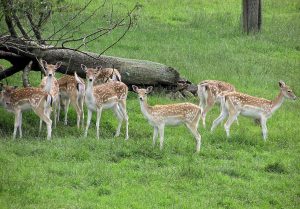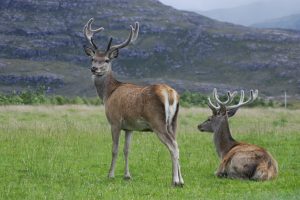We do too. But do you want to go out and see them?
Show me Wild ExperiencesKeep up to date with the hottest wildlife content on the web and save £10 on your first wildlife experience.
Sign Me Up!
Fallow deer
The UK is home to six species of deer – the red, roe, fallow, Sika, muntjac and Chinese water deer. Of the six, only the red deer, Britain’s largest land mammal, and the roe deer are indigenous. Meanwhile, while it may not be native to Britain, the fallow deer are usually seen as such since they have been in the country since the 11th Century. Meanwhile, it has been around 150 years since the muntjac, Sika and Chinese water deer were introduced in the country. Among the six species, the red and the fallow deer are the most common in the UK.
Given their large population, deer can easily be spotted anywhere, from grassland to woodland. There are also estates and parks where these animals are managed. One of the favourite parks for deer watching is Richmond Park which is home to 630 freely roaming red and fallow deer. Other places worth visiting for deer watching include Lyme Park, Woburn Abbey, Wollaton Park and Tatton Park.

Red deer
Why Is There A Deer Overpopulation In The UK?
Currently, Britain is experiencing what’s called a deer population explosion. It is estimated that there are already 2 million deer in the country. This is the highest figure ever recorded in a thousand years. Some places around the world like New York are also experiencing an overabundance of this animal.
Since 1999, the number of deer has already been doubling in the UK. Experts cite the absence of natural deer predators in the country as one of the reasons for the overpopulation. There’s also the fact that these animals are protected from being hunted and being treated as pests under the 1963 Deer Act. Records show that, since the implementation of this legislation, deer population has steadily grown.
What’s The Problem With Deer Overpopulation?
An extremely high deer population has harmful effects on human activities. First, they may cause road mishaps. According to reports, they are responsible for 50,000 traffic accidents annually. Moreover, approximately 20 people die each year due to vehicle-deer collisions. In Scotland, the cost of road accidents due to these animals is estimated to be £7million. Also, these collisions cause 50 to 100 cases of human injuries.
The accidents typically happen in the early evening. They are also more prevalent during autumn season as well as the months of May and June. Given the aforementioned dangers, the government has tirelessly reminded citizens to observe caution when driving, especially during the months wherein more deer are on the roads.
Aside from causing road accidents, deer also bring health hazards to humans. For example, disease-carrying ticks on these animals may bite people causing them to become sick with Lyme disease. Around 2000 to 3000 cases of this disease are recorded each year in the country. Although health experts believe the number could be higher since this illness is often undiagnosed or misdiagnosed in patients.
The deer overpopulation is also causing problems for the agriculture sector. Those heavily affected are usually farmlands which are adjacent to a woodland. Aside from being eaten, crops die because deer trample on them. With their plants destroyed, farmers suffer from financial woes.

A deer feeding
Aside from affecting human activities, the overabundance of deer is also hurting other plant and animal species. For one, a high number of deer may lead to overbrowsing of woodland. In fact, scientist noted that there’s almost a 70% decrease in foliage of below two metres in areas with dense deer populations. Consequently, the destruction of the plants and trees is leaving woodland birds homeless. Among those affected are woodland songbirds like the turtle dove whose population declined by 77% in the past ten years. Furthermore, the nightingale has now been added to the list of most threatened species. The decline in their number is attributed to the muntjac deer feeding on their habitat and breeding places.
What Can Be Done To Address Deer Overpopulation?
Seeing how the overabundance of deer is changing forests and putting other species at risk of extinction, scientists say that deer cull is already necessary at this point. Given the current deer population, around 50% to 60% of deer need to be killed to achieve the right or a favourable density. Should this be done, those working for the protection of deer insist that the cull must be done in a humane manner.
As the aforementioned solution sounds cruel, some researchers are suggesting that the animal’s meat be harvested and that venison consumption be promoted. They say that doing this will not just reduce deer population; it will also give people a sustainable food (or venison) source.
There are also those who are proposing the lifting of deer hunting restrictions. This includes allowing hunters to take deer outside the hunting seasons. Some are also proposing that specialised methods or techniques be allowed to achieve favourable results.
Lastly, some experts are recommending the reintroduction of wolves and lynx into Britain. This so-called natural solution may result in a significant decline in the deer population in 20 years. However, this suggestion is facing strong opposition from sheep farmers who claim that these animals are going to put other species at risk.
—
Fallow Deer
Image Attribution: By Adrian Pingstone (Own work) [Public domain], via Wikimedia Commons
Image Resource: https://commons.wikimedia.org/wiki/File%3AFallow_deer_arp.jpg
Red Deer
Image Attribution: By Mehmet Karatay (Own work) [CC BY-SA 3.0 or GFDL], via Wikimedia Commons
Image Resource: https://commons.wikimedia.org/wiki/File%3ARed_deer_stags.jpg
A Deer Feeding
Image Attribution: Iwctoys at the English language Wikipedia [GFDL or CC-BY-SA-3.0], via Wikimedia Commons
Image Resource: https://commons.wikimedia.org/wiki/File%3ADeer-Eating.jpg